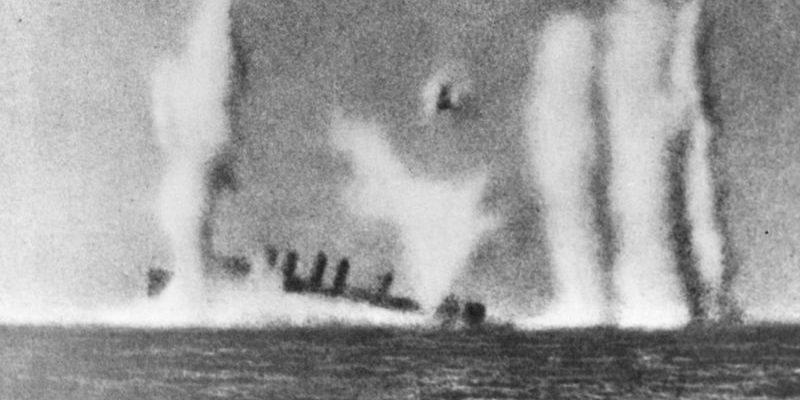
The wreck of a US warship sunk in a World War II battle dubbed one of the bravest ever stands by a US Navy vessel has been found in the depths of the Pacific, US and Australian officials announced Monday.
Known as the “dancing mouse” due to its slippery movements in that final, fatal fight with the Imperial Japanese Navy, the destroyer USS Edsall went down off the coast of Australia in 1942, under the command of Lt. Joshua Nix.
“Joshua Nix and his crew fought valiantly, evading 1,400 shells from Japanese battleships and cruisers before being attacked by 26 carrier dive bombers, taking only one fatal hit,” US Ambassador to Australia Caroline Kennedy said Monday in announcing the find of the Edsall’s wreck.
Speaking alongside Kennedy, Australia’s chief of navy, Vice Adm. Mark Hammond, said the wreck was found with the help of advanced hydrographic survey capabilities aboard naval support ship MV Stoker.
Hammond also praised the Edsall crew for fighting a string of battles to help protect Australia during the early days of World War II before the vessel sunk on March 1, 1942.
On that day, a Japanese carrier-based plane spotted the US destroyer around 200 miles south-southeast of Christmas Island, according to an account of the Edsall’s final battle on the website of the US Naval History and Heritage Command (NHHC).
Japanese Vice Adm. Chuichi Nagumo was reportedly “incensed” that the US warship was spotted within 16 miles of his forces and ordered them immediately to intercept, according to the NHHC account by director Samuel Cox.
The old US destroyer – Edsall was commissioned in 1920 – and its 4-inch guns would prove to be no match for the newer Japanese fleet with bigger guns and dozens of aircraft carrying 500-pound bombs.
“Nix’s position was hopeless from the moment Edsall was sighted,” Cox wrote.
But the captain of the US destroyer didn’t give up.
“As a last gesture of defiance, like the famous cartoon of the little mouse flipping the bird at a huge screaming eagle, Lieutenant Nix chose to make a fight of it,” Cox wrote.
He had the destroyer lay a smokescreen, execute course changes and change speeds to evade the Japanese shells while launching torpedoes that narrowly missed one Japanese warship.
After seeing Edsall evade more than a thousand 14-inch and 8-inch shells, Japanese commanders ordered dozens of dive bombers from their three aircraft carriers to strike, according to Cox’s account, which he wrote was derived from Japanese sources.
At least one hit Edsall, and the ship began to lose its ability to maneuver.
“With fires raging and the ship settling and losing way, Lieutenant Nix pointed the bow of Edsall at the Japanese surface ships in his last act of defiance” and ordered ship abandoned, Cox wrote.
The Japanese warships then turned their big guns on the disabled destroyer, finally sinking it.
But Nix’s maneuvers drew the respect of Japanese witnesses, Cox wrote.
“According to a Japanese observer, Edsall performed like a ‘Japanese dancing mouse’ (a popular domesticated pet in Japan, also known as ‘waltzing mice’ or ‘whirler’ for its manic and bizarre movements),” the US naval historian wrote.
‘Don’t give up the ship’
Following the announcement of the wreck’s discovery, officials were effusive in their praise of Nix.
“The commanding officer of Edsall lived up to the U.S. Navy tenet, ‘Don’t give up the ship,’ even when faced with overwhelming odds,” the US chief of naval operations, Adm. Lisa Franchetti, said in a statement Monday.
“The wreck of this ship is a hallowed site, serving as a marker for the 185 U.S. Navy personnel and 31 U.S. Army Air Force pilots aboard at the time, almost all of whom were lost when Edsall succumbed to her battle damage.”
While most of those aboard the Edsall died at sea that day, some were rescued from the water by the Japanese and taken prisoner.
After the war’s end, six decapitated bodies found in graves on Celebes Island (now Sulawesi, Indonesia) were identified as those of Edsall crew members. Five more bodies found in the graves were not identified but were believed to be those of US pilots who had been aboard the ship, according to Cox’s account.
He called the story of the Edsall “one of the most gallant and valorous actions in the history of the U.S. Navy.”
Historian and author Trent Hone cited Edsall’s ultimate battle as “the most courageous independent action by a US Navy surface ship in combat,” in a 2020 survey by the US Naval Institute’s Proceedings magazine.
Franchetti said Monday that the story of the Edsall, both in its defense of Australia in 1942 and in the cooperation shown by the two allies in finding the wreck this year, shows the strength of that trans-Pacific alliance.
The discovery highlighted the current AUKUS partnership, between the US, Australia and the United Kingdom, she said.
“A key component of AUKUS is the development of the most cutting-edge underwater technologies of the type that enabled the discovery of Edsall in the vastness of the Indian Ocean, something not possible just a few years ago,” Franchetti said.
That ability helps “ensure our collective capability to preserve the peace, respond in crisis, and win decisively in war, if called,” she added.










